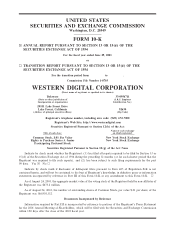Western Digital 2001 Annual Report Download - page 20
Download and view the complete annual report
Please find page 20 of the 2001 Western Digital annual report below. You can navigate through the pages in the report by either clicking on the pages listed below, or by using the keyword search tool below to find specific information within the annual report.manufacturer and distribution customers and brand equity with its end users. These product performance
attributes include seek time, data transfer rates, intelligent caching, failure prediction, remote diagnostics,
acoustics and data recovery. Rapid response requires accelerated design cycles, customer delivery and
production Öexibility, which contribute to customer satisfaction. Data storage has become strategically critical
for computer end users. Consequently, the Company believes that trust in a manufacturer's reputation has
become an important factor in the selection of a hard drive, particularly within such a rapidly changing
technology environment. The Company believes it has strong brand equity with its end users.
The Company completed its transition to magnetoresistive technology in 1999 and completed its
transition to giant magnetoresistive technology in 2000. During the Ñrst quarter of 2000, the Company lost
market share as a result of a product recall; however, the Company recovered some of its market share as it
regained a leadership position in quality and time-to-market during the remainder of 2000 and continued to
regain market share during 2001.
The desktop hard drive market is characterized by many competitors and short product life cycles;
therefore, it has traditionally been subject to periods of sustained and severe price competition, and factors
such as time-to-market can have a pronounced eÅect on the success of any particular product.
Advances in magnetic, optical or other data storage technologies could result in competitive products that
have better performance or lower cost per unit of capacity than the Company's hard drive products.
High-speed semiconductor memory could compete with the Company's hard drive products in the future.
Semiconductor memory is much faster than magnetic disk drives, but currently is volatile (i.e., subject to loss
of data in the event of power failure) and much more costly. Flash memory, a nonvolatile semiconductor
memory, is currently much more costly and, while it has higher ""read'' performance than hard drives, it has
lower ""write'' performance. Flash memory could become competitive in the near future for applications
requiring less storage capacity than that provided by hard drives.
For an additional discussion of competition, see Part II, Item 7, under the heading ""Risk factors related
to the hard drive industry in which we operate.''
Service and Warranty
Western Digital generally warrants its newly manufactured hard drives against defects in materials and
workmanship for a period of one to three years from the date of sale. The Company's warranty obligation is
generally limited to repair or replacement of the hard drive. The Company has contracted with a third party in
the United States to process and test returned hard drives for the Company's end users. The Company
refurbishes or repairs its products at third-party service facilities located in Singapore and Germany.
Manufacturing
To be competitive, Western Digital must manufacture high quality hard drives with industry leading
time-to-volume production at competitive unit costs. The Company strives to maintain manufacturing
Öexibility, high manufacturing yields and high-quality components at competitive prices. The critical elements
of Western Digital's hard drive production are high volume, low cost assembly and testing, and establishment
and maintenance of key vendor relationships in order to create ""virtual vertical integration.'' By establishing
partner relationships with its strategic component suppliers, the Company believes it is able to access ""best-of-
class'' manufacturing quality without the substantial capital investment associated with actual vertical
integration. In addition, the Company believes that its virtual vertical integration model enables it to have the
business Öexibility needed to select the highest quality low cost suppliers as product designs and technologies
evolve.
Hard drive manufacturing is a complex process involving the assembly of precision components with
narrow tolerances and extensive testing to ensure reliability. The assembly process occurs in a ""clean room''
10
























